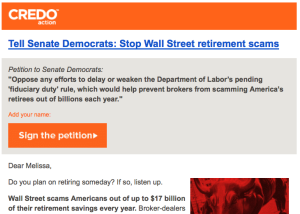After a great run, the Winning the Internet blog has been retired. However, you can still keep in touch with New Media Mentors here.
If you’re looking for email best practices, you’re in the right place! It’s important to pause from time to time and read up on what works well for others in your field, so it’s great that you’re doing this. While this certainly isn’t an exhaustive list of email best practices, these practices tend to be a central part of successful email programs.
Without further ado…
1. Always provide value.
Any email that you send to your list absolutely must provide value to the recipients. Nobody wants to spend time reading something that isn’t relevant to his/her life, is boring, or feels like a waste of time. This is by far the most important thing to keep in mind when running an email program.
When you’re working on an email, try to put yourself in the shoes of the recipient and ask yourself “What’s in it for me?” and “Why do I care about this?” If you can’t answer those questions in a compelling way, don’t send the email.
Also try to make your emails as timely and relevant to the recipient’s specific situation as possible. Emails that relate to something that’s being covered in the news at that time usually perform better. The same is usually true for emails that use segmentation to make sure they’re only sent to people that really care about that particular topic (usually segmenting by interest area, geographical area, past engagement/donation history, etc.).
2. Be authentic and approachable.
Ultimately the voice you use in your emails should depend on your audience. A bunch of policy wonks might have a higher tolerance for lengthy detailed text than busy moms. However, in most cases an authentic, approachable voice works well. Some people find it helps to imagine they’re writing to a friend when they draft mass emails. The bottom line here is that for most audiences you don’t want to be too longwinded or dry. These are surefire ways to get a reader to move on to the next message in his/her inbox.
3. Write compelling copy.
“Writing compelling copy” probably sounds like a no-brainer, but it’s something people often struggle with. In general, it’s a good idea to be direct and to the point (it’s unlikely that your readers are willing to stay with you through lengthy intro text until you finally get to the point). It’s also a good idea to explain why whatever you’re asking them to do is important (basically clarifying your theory of change). People are busy. Don’t make them spend time trying to read between the lines.
Finally, goals, deadlines and outside validation are all great tools for pushing someone to take action. The clearer you are about what you’re trying to do and why, the better.
4. Make it easy to scan and act.
Again, people are busy. Most audiences respond well when you make it easy for them to get the gist of what you’re asking quickly and take action. There are a bunch of different ways to do this, but some of my favorites include:
- Using bullets for lists
- Bolding critical info
- Placing critical information above the fold (so readers don’t have to scroll down to see it)
- Using clickable buttons and call-out boxes
- Using graphics when they help you tell your story
Below is a screen shot from an email sent by CREDO Action recently. Notice that the call to action appears right at the top, followed by a call-out box that summarizes what they’re asking you to do. All of that appears before the email text itself. This email has clearly been optimized for scanning and acting.
 Another part of making it easy for your supporters to scan and take action is making sure your emails look good on mobile devices. The easiest/cheapest way to check this is to look at an email you sent recently on your own device, and have your colleagues do the same. There are mobile device simulating tools available online, but they tend to cost money. If your email does not look good on a mobile device, you need to alter your email template. If you’re not sure how to do this, asking your email provider is a good first step.
Another part of making it easy for your supporters to scan and take action is making sure your emails look good on mobile devices. The easiest/cheapest way to check this is to look at an email you sent recently on your own device, and have your colleagues do the same. There are mobile device simulating tools available online, but they tend to cost money. If your email does not look good on a mobile device, you need to alter your email template. If you’re not sure how to do this, asking your email provider is a good first step.
5. Use catchy subject lines
Subject lines are critical. After all, it doesn’t matter how incredible the text of your email is if your subject line isn’t compelling enough for people to open the message. For this reason, at a past Netroots Nation training the folks from Upworthy suggested spending 75% of your time writing subject lines and 25% of the time on your actual message. Personally, I think it would be tough for most nonprofits to actually do that, but their point is an excellent one; subject lines are critical and worthy of your time and attention. In this spirit, I suggest pushing yourself to write 10 or ideally 20 subject lines for every email you send, then using the best one or two. Most of us can do that without adding a ton of time to the email development process.
As for what makes a good subject line, that very much depends on your list. In my experience, every subject line is a snowflake. There isn’t a tried and true approach that works for everyone, though most folks find including goals and deadlines helpful. Again, you want to compel someone to open the message because they find it interesting and relevant. Here are a few examples I came across in my inbox recently that resonated with me:
Sign the petition: Stop Monsanto and the Koch Brothers
This one is from CREDO Action. I like this one because it makes it clear up front that they need the recipient’s help (“Sign the petition”). It also specifically names a couple of entities that are notoriously hated by the left (“Monsanto and the Koch Brothers”). People tend to have an emotional reaction to villains.
Child laborers poisoned — in the US?!
This one’s from Avaaz. I included this because it’s emotionally disturbing (children are being poisoned) and shocking (the poisoning is happening in the US).
Secret Service Agents Really Glad Dark Sunglasses Hide Bloodshot Eyes
This one’s from HuffPost Hill. While this one’s a little long, it stands out to me because its topical and humorous.
The best way to make sure you’re choosing winning subject lines is to test them.
6. Keep people engaged.
Sometimes people ask me how much email they should be sending. The truth is that there’s no hard and fast rule here. In most cases you can send lots of email to your list as long as they follow best practice #1 and truly provide value to the recipient. However, there is a danger of messaging people too infrequently. You don’t want your supporters to forget about your organization/work. For most lists, emailing twice a month is a reasonable minimum.
7. Test, test, test!
Following best practices is a good first step, but if you’re already doing this and want to get even more out of your email program, you’ve got to start testing. Best practices are great but they’re based on what works best for most organizations. When you do testing, you can find out exactly what works best for your specific audience.
It’s a good idea to get in the habit of doing subject line testing for every email you send. Other things that are worth testing include:
- Email header
- Call-out box
- Take action buttons
- Strategic emphasis (ex: bolding so things are easier to read)
- Wording/emphasis for call to action
- Text length
- Text style
- Images
- From names
It would be naive to call this an exhaustive list of best practices (there are so many!), but this should be a very solid starting point. If you’re already following all of these, kudos to you! You’re ahead of most folks and are probably running a pretty great email program.




Comments are closed.